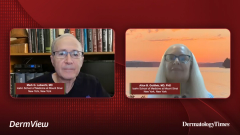
Role of IL-17 Inhibitor Durability in Plaque Psoriasis
Mark G. Lebwohl, MD, and Alice B. Gottlieb, MD, PhD, discuss the durability of IL-17 inhibitors in managing plaque psoriasis.
Episodes in this series

Mark G. Lebwohl, MD: Let me ask another question about a recently published study that suggested that IL [interleukin]-17 inhibitors are more durable than the effect you get from TNF [tumor necrosis factor] inhibitors. And IL-12/23 inhibitors, which took me by surprise. But does treatment durability impact your treatment selection?
Alice B. Gottlieb, MD, PhD: The simple answer to that question is yes. Is it the first thing that comes to mind? Probably not. But yes, it’s a big plus for a drug if they have it. It also may be a big plus in the business world of medicine because one of the things that payers can use to zing a doctor is how many switches and treatment they do. In this era of defensive medicine, it can be a plus, but truth be told, it is not the top 3 on my list that I consider.
Mark G. Lebwohl, MD: Yes. Patients are happy to continue giving them some of the medications to stay clear, I agree with what you said. I will say I was surprised by the IL-12/23 inhibitor finding but think about this. If you use PASI [Psoriasis Area and Severity Index] 75 as an end point. IL-12/23 inhibitor ustekinumab does quite well. And that effect is quite durable. You keep it up every 3 months. And there are many studies that have shown that. If you end up using Patient Safety and Adverse Events Composite [PSI 90] or higher bar, the IL-17 inhibitors are much more effective than IL-12/23 inhibition. And of course, both drugs are more effective than TNF inhibitors. The durability of response depends on how you define durability. But yes, the IL-17s give a great response. The IL-23 blockers are given as infrequently as every 2 or 3 months because their effect is quite durable. So they are also quite useful in this regard.
Alice B. Gottlieb, MD, PhD: How I explain it sometimes to patients is that the IL-23 blockers knock out the factory that makes the guns and the IL-17 blockers are knock-outs, the guns, so to speak. You’ll get a more rapid response because you’re getting rid of the guns. But at the same point, it takes longer to rebuild the factory. That may be overly simplistic, but it gets the point across.
Mark G. Lebwohl, MD: Absolutely. It clearly gets the point across.
Transcript edited for clarity
Newsletter
Like what you’re reading? Subscribe to Dermatology Times for weekly updates on therapies, innovations, and real-world practice tips.




















